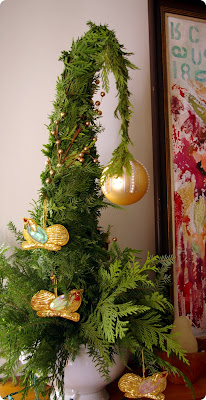Inspiration: folding fabric + ribbon into candies + flowers
Candace Kling made these fantastic mixed-media candy boxes by folding and pressing ribbon into delectable shapes ...
 {Candace Kling, Candy Sampler: Crème de la Crème, 1998, John Bagley photograph}
{Candace Kling, Candy Sampler: Crème de la Crème, 1998, John Bagley photograph}
Tsumami Kanzashi are these beautiful hair ornaments typically worn by the Geisha in Japan. They are exquisite hair pins made from thin silk called 'habutae,' often designed to resemble flowers or butterflies. This ancient Japanese craft dates back to the Edo Period (1603-1867) and nowadays are only worn with traditional Japanese attire on special occasions.
Atelier Kanawa makes these amazing hairpieces from kimono fabric ... One of her creations is shown below ...
Yonuko is another artist who creates these traditional Japanese hairpieces ... Here is an
article where she discusses her work and the process that goes into making these intricate hairpieces ... Some of her work is shown below ...
Seasonal Kanzashi - The seasons dictate which kind of hair ornament is worn in Japan. Usually this applies above all to the
geisha and maiko, who tend to be the only Japanese women to wear kanzashi often enough for seasonal changes to be noticeable. Since maiko wear more kanzashi than senior geisha, seasonal changes are even more important for them. (Wikipedia)
- January - The design of January kanzashi differs from year to year, but usually has an auspicious Japanese New Year theme. Shouchikubai is a popular choice, a combination of pine (matsu), bamboo (take) and ume plum blossoms, (green, red and white) which are usually associated with celebrations.
- February - Usually trailing deep pink, or sometimes red, ume plum blossoms, which are to be seen everywhere in Japan at this time and symbolize young love and the approach of spring. Another less common theme is the pinwheel.
- March - Trailing yellow and white rape blossoms (nanohana) and butterflies, as well as peach blossoms (momo), narcissi (suisen), and peonies (botan).
- April - Trailing soft pink cherry blossom (sakura) mixed with butterflies and bonbori lanterns, signaling the approach of summer. Cherry blossom viewing at this time of year is a major cultural event in Japan. Also, kanzashi consisting of a single silver (or sometimes gold) butterfly (cho) made of mizuhiki cord are common.
- May - Trailing purple wisteria (fuji) and flag irises (ayame), usually of the blue variety. Irises denote the height of spring. Small silver butterflies also pop up as extra decorations in May.
- June - Trailing green willow (yanagi) leaves with pinks, or less commonly hydrangea (ajisai) flowers. Willow is a traditional image associated with geisha. This month is the rainy season in Japan, and therefore willow (a water-loving tree) and the washy blue of hydrangea are appropriate.
- July - Kanzashi featuring a display of fans. These will usually be of the round uchiwa variety, but occasionally folding dancing fans are also featured. The fans refer to the Gion Festival which takes place at this time, a huge event held at the Gion geisha district in Kyoto, which involves hundreds of traditional dances by geisha. Fans are a staple component of traditional Japanese dance. The fans featured in a maiko's July kanzashi vary each year, in line with the Festival. There are common themes such as dragonflies and lines denoting swirling water. Other kanzashi worn during July are the fireworks kanzashi and tsuyushiba (dewdrops on grass).
- August - Purple morning glory (asagao) or susuki grass. The susuki grass appears as a starburst of spines. Senior maiko wear silver-white and junior maiko wear pink or red.
- September - Japanese bellflower (kikyo). The purple tones are traditionally associated with autumn. Often these will be mixed with the other autumn flowers: bush clover, patrinia, chrysanthemum, Japanese boneset, kudzu, and pinks.
- October - Chrysanthemum (kiku). These are well-loved in Japan, and are a symbol of the Imperial Family. Usually the chrysanthemums featured are red and white, a combination which signals the height of autumn.
- November - Trailing autumnal leaves. These may be a generic yellow leaf or the characteristic red maple leaf. Maple viewing is the autumnal equivalent in Japan of cherry blossom viewing. Ginkgo and liquidambar leaves are also employed.
- December - The Japanese make mochi at this time of year, and often decorate trees with them to represent white flowers. It is thought to be good luck to wear kanzashi featuring mochibana, or rice-cake flowers. December kanzashi also feature two maneki, which are tiny blank tags. Traditionally maiko visit the Minamiza Theatre and ask two of their favourite Kabuki actors to autograph them with their Kabuki nom de plume. Some December kanzashi also include bamboo leaves.
- New Year - At this time of year all maiko and geisha wear unhusked rice ears on the right side of their coiffure. These kanzashi also feature eyeless white doves. The maiko and geisha fill in one eye and ask somebody they like to draw the other.

























































